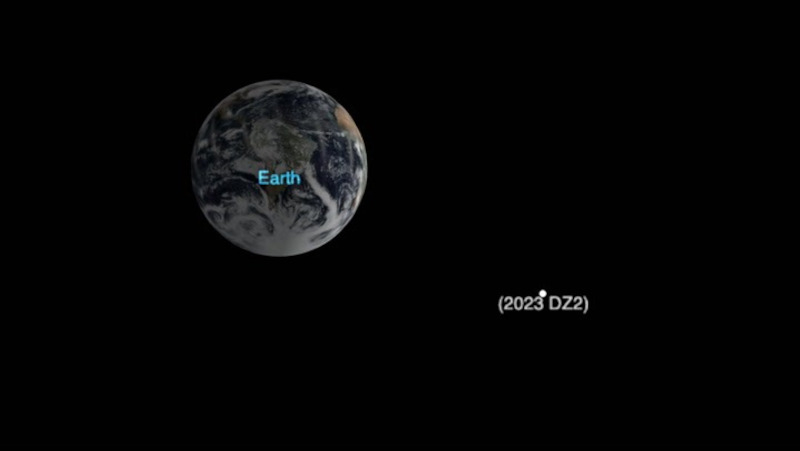
Asteroid with a diameter of 44-99 m to approach Earth on March 25
An asteroid three times the size of one that exploded in the skies of Chelyabinsk causing damage to both people and buildings in 2013 is approaching the Earth. The asteroid named 2023 DZ2 will pass by the Earth on March 25 at a fairly close distance.
According to scientists' calculations, 2023 DZ2 will pass the Earth at a speed of 28,044 km/h. It will reportedly be visible from the Northern Hemisphere even with relatively small telescopes. In addition, on Sunday at 03:30 Yerevan time, The Virtual Telescope Project will broadcast live the flight of the object past the Earth.
When viewed through a telescope from the Northern Hemisphere, the asteroid will look like a slow-moving star and will be closest to Earth on March 25 (Saturday) at 10:52 a.m. Yerevan time.
The asteroid was discovered by astronomers of La Palma (Canary Islands) observatory in February this year, it has a diameter of 44-99 m. Since the asteroid's trajectory crosses the Earth's orbit, it belongs to the Apollo class of asteroids. The exact origin of 2023 DZ2 is unknown. According to Earthsky.org, most of these objects come from the asteroid belt between Mars and Jupiter, leaving their orbits due to "unsuccessful" interactions with the gas giant.
By the way, the asteroid that exploded in the sky of Chelyabinsk had a diameter of 18 m and as a result of its explosion 1,400 people were injured, about 7000 buildings were damaged. 2023 DZ2 is actually about three times bigger than that. In the event of a possible collision with Earth, it could probably cause three times as much damage.
Fortunately, according to data from the Virtual Telescope Project, it will come as close as 173,000 km to our planet. For comparison, the average distance from the Earth to the Moon is 384,400 km. According to Space.com, judging by the available information about the orbit of 2023 DZ2, the probability of this asteroid colliding with Earth is extremely small.

What is being done to protect against asteroids?
Large meteorites can cause serious destruction if they reach the Earth. Scientists believe that the largest near-Earth asteroids with a diameter of more than 1 km can cause catastrophic changes in the event of a collision with the Earth, in such a scenario, they can destroy human civilization and even lead to the complete extinction of the species. Smaller objects ranging from 140 m to 1 km in diameter can cause regional disasters when they collide with Earth, destroying up to entire continents and killing hundreds of millions of people.
To avoid such scenarios, scientists constantly study the universe in order to know in advance about potentially dangerous asteroids. As part of protecting the Earth from such asteroids, NASA successfully implemented the DART (Double Asteroid Redirection Test) mission last fall. The DART probe hit Dimorph orbiting Didymus to see if it was possible to artificially alter the asteroid's orbit. The results of the mission exceeded the expectations of scientists. According to them, the collision should have changed the asteroid's rotation time by about 73 seconds, but in fact it changed it by 32 minutes, and now one complete rotation takes 11 hours and 23 minutes.
NASA also plans to use the Near-Earth Object (NEO) Surveyor telescope, which should be launched in 2026, to detect potentially dangerous objects for Earth at an early stage. It is expected to be able to survey the Solar System very efficiently — including blind spots caused by sunlight.
Last year, China proposed a new system for warning about dangerous asteroids. It proposes to deploy a new system consisting of six spacecraft in orbits similar to Venus with the purpose of detecting asteroids potentially threatening the Earth as soon as possible and warn about it.
However, there are so-called potential planet-killing asteroids that are difficult to detect because they "hide" in the light of the Sun and telescopes cannot capture them. One such asteroid (2022 AP7) was discovered in November 2022.
- Related News
- "AMADEE-24" Mars Analog Research Mission in Armash came to an end
- NASA creates new generation solar sail: What is it for?
- Flying object resembling surfboard was detected in Moon’s orbit: What is it in fact?
- Total solar eclipse on April 8, 2024: The most impressive photos
- Total eclipse of Sun will take place today: From which parts of the country will it be seen?
- Amateur astronomer from Crimea discoves potentially dangerous asteroid for Earth
- Most read
month
week
day
- iPhone users are advised to disable iMessage: What risks are hidden in it? 1408
- New Macs based M4 chip will get up to 512 GB of integrated memory, M4 is expected to be released in late 2024 1147
- Problems with Android 15: NFC contactless payments no longer work on smartphones with updated operating systems 1101
- Pavel Durov gives interview to Tucker Carlson: From 3-hour interview, less than hour appears in final version 987
- What are the best selling smartphones in the world? 863
- AMD Ryzen 7 processor, 24 GB of RAM and only $550: Mechrevo presents inexpensive and powerful laptop (photo) 763
- The 5 most controversial buildings ever built: Bold design or complete failure? (photo) 757
- Key Google Pixel feature will soon be available on iPhone as well 754
- Wildberries Travel service is already available for Armenia and other CIS countries 739
- Black Shark smart ring from Xiaomi to have interesting characteristics and phenomenal autonomy: 180 days of operation without recharging (photo) 730
- Archive
